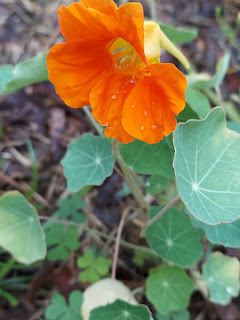If you are new to gardening, winter might not seem like a
very active time for your hobby. But that is not true. Gardening is a year
round activity.
- Winter is the time for planning for the next growing
seasons. I find it is exciting to think about what is possible. Have some
fun flipping through seed catalogs and library books. The sky is the limit,
nothing fails, you have all the time and money you need! Capture your ideas in
a notebook or other method, no matter how big or small, because you probably
won’t be able to do everything this year, but you will capture your ideas for
the future.
- Planning is really important, too, because you want to
be ready to start planting in the spring. You need the dirt to be ready,
you need some plants to stick in the ground or your containers, you need some
seeds to plant, you might need a new tool or a new pot. Nothing is more
frustrating when you pick a Saturday morning to start planting and you realize
you can’t find your trowel or your container is cracked.
- Finally, planning is easier on your budget,
because you can spread your spending out over many months rather than having a weekend-long
spending spree. It will limit impulse buying when you are standing at the
garden center, completely overwhelmed.
#gardengoals
I am not a trained farmer, I don’t have any education in horticulture
or botany. I simply have an interest in growing things. I work full-time and
have a family that takes a lot of my attention so I do not have unlimited time.
And it is just me doing most of the work. (My honey loves the flowers that I
grow every summer, but he is not interested in helping me with projects and I
have accepted that.) I also have a limited budget for plants, tools, amendments,
and labor. But I do have beautiful gardens every year and I have a lot of fun and
get a lot of pride and satisfaction growing flowers, vegetables, and herbs.
Setting #gardengoals keeps me focused because I am one
person and I can only do so much in 12 months. If I am puttering around week
after week without focus, the things that need attention don’t get done. Concentrating
on a small number of things ensures that least a few things are actually
completed every year.
Take a few minutes this week and write down the things
you really want to accomplish this year. Maybe it’s grow a tomato or create a rose
bush hedge or start composting. Here's my list:
- Clear another bed near the dahlia bed
- Replace the rotted raised vegetable bed
- Keep the new crepe myrtle alive
- Figure out the bed near the shed – is it shady? part shade? full shade? Why do I hate that section of the yard so much even though it is so central to the backyard?
- Try growing two new summer vegetables
- Dress up the patio with larger rectangular planters to hide the utilities
Back in 2019, I made my garden goals public by posting them here in my blog. Looking back
recently at this post, I recognized that I actually met most of the goals I set!
I am proud of myself. Maybe I am better at keeping goals than I thought?
Start here
Over the next few blog posts, I am going to share some simple steps to get you started growing flowers and vegetables. I am excited to help you get started on your gardening journey no matter where you are growing. It could be your windowsill or some pots on your patio or stoop. Maybe you have a plot in your community garden or have some space in your backyard. All of those places are excellent places to grow some plants. Starting something new can be overwhelming. Start small, be realistic, and have fun with your successes and failures. So start with writing down a few goals for this year and check back through the spring and summer to see how you are progressing.
